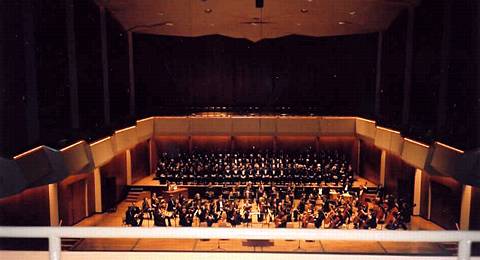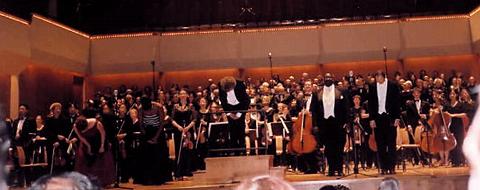|

Creative reinterpretation
The 'Missa Solemnis' in facsimile and performance. MALCOLM MILLER attended a conference and concert at the University of Illinois in Urbana-Champaign
A stirring and in many ways uniquely re-creative interpretation of Beethoven's choral masterpiece the Missa Solemnis was given on 6 May 2003 in the Froelinger Great Hall of the impressive Krannert Centre at the University of Illinois at Urbana-Champaign, south of Chicago, USA. Four young soloists, graduates and on their paths to promising operatic careers, combined with the vast forces of the University Oratorio Society, Chamber Singers and Symphony Orchestra under their charismatic conductor Fred Stoltzfus, in an exciting recreation of this monumental religious yet profoundly humanistic work which emanates from Beethoven's late period. Yet the performance was also unique as it formed the climax of a Beethoven season, the highlight of which was an international conference on 'Beethoven's Creative Process.'

The orchestra and choir at the 'Missa Solemnis' concert.
|
The event was organised at the University's Spurlock Museum on 2-4 May 2003 by the leading Beethoven authority William Kinderman, who also launched his latest study, a facsimile, transcription and commentary of Artaria 195, the sketchbook used for both the Missa Solemnis and the Piano Sonata Op 109. Published by the University of Illinois Press, this is the first facsimile of the sketchbook and has given rise to a host of new discoveries about Beethoven's late style and the significance and genesis of this great choral work. Kinderman's own ground-breaking presentation explored where Beethoven's inspiration came from and how it evolved. He showed how the sketchbooks were remarkable in being filled with short piano pieces, pieces hitherto unrecognised and which seemed to be essaying musical devices which are later blown up to a huge proportion in the larger choral work. The significance and genesis of the Missa Solemnis was also the subject of an entire conference session, with a fascinating paper by Birgit Lodes, Professor at Munich University, about Beethoven's understanding of the Latin Mass via particular contemporary German translations. James Parsons (Southwest Missouri State University) gave a stimulating exploration of the lofty moral and aesthetic shared with the Choral Variations and Ninth Symphony, while Effie Papenikolaou (Miami University) offered a fascinating interpretation of the Missa Solemnis in the tradition of nineteenth century masses, suggesting that the work's double character of concert hall and church anticipated masses by Bruckner, Verdi and even the choral symphonies of Mahler.

Receiving applause at the end of the 'Missa Solemnis' concert
|
Certainly the performance of the Missa Solemnis gained in intensity and effect in the context of the conference, from the powerful choral entry with which the dynamic 'Kyrie' sprang into life, to the final chords of the 'Agnus Dei'. In the 'Kyrie' the broad lyrical gestures flowed expressively, weighty orchestral textures in support, and a resonant tenor soloist Henry Pleas in dialogue with the mellow horn. There was even more blazing power to the 'Gloria', the brass almost overwhelming the voices, which raced with energy and ebullience in the perilously paced fugue. The 'Credo' was manoeuvred with suitable gravitas, and here the initial fugal motif was boldly highlighted. Stoltzfus elicited a sonority that characterised the text beautifully, with the shift to low register at 'Et incarnatus est' announced by Timothy Schmidt, bass, and a vigorous return to celestial glory. The soprano Elisabeth Ducey was especially resilient and with Christin-Marie Hill, mezzo and the two male voices, the a capella passages were lucidly textured. Most eloquent of all was the sweet tone of the solo violin in the 'Benedictus', this concerto in miniature adding to the heterogeneous genre of the whole, part-oratorio, part-operatic, part-cantata. It was in the 'Agnus Dei' that inwardness and devotion emerged as the telling qualities, Beethoven's word-setting strikingly conveyed. Overall the performance reflected the high standards of student music-making at this important academic centre and in the superbly appointed concert halls of the Krannert Centre.
Continue >>
Copyright © 7 August 2003
Malcolm Miller, London, UK

|

